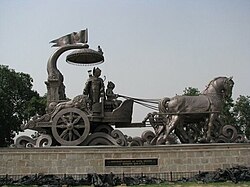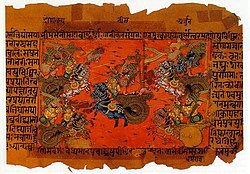Kurukshetra War
The Kurukshetra War was described in the Indian epic poem Mahābhārata.
There it is said the war took place in Mahabharata. It lasted 18 days.[1][2]
Kurukshetra War Media
The approximate extent of Āryāvarta during the late Vedic period (ca. 1100-500 BCE). Aryavarta was limited to northwest India and the western Ganges plain, while Greater Magadha in the east was habitated by non-Vedic Indo-Aryans, who gave rise to Jainism and Buddhism.[3][4]
Description* Mahabharata, Sanskrit epic poem. War council at Kuru. Liebig collectors' card 1931 S1247 (F1246) Photo credit Lebrecht History / Bridgeman Images Keywords 20th century / religious / drawing / indian / hinduism / hindu / drawings / poetry / poem / india / illustrations / twentieth century / literary arts / literature / history / religion / illustration
Krishna displays his Vishvarupa (universal form) to Arjuna on the battlefield of Kurukshetra.
Bhishma on a deathbed of arrows, from a collection of the Smithsonian Institution
References
- ↑ Devdutt Pattanaik. Jaya: An illustrated retelling of the Mahabharata. ISBN 978-0143104254
- ↑ Murthy S.S.N. 2016. The questionable historicity of the Mahabharata. Electronic Journal of Vedic Studies. 10 (5): 1–15.
- ↑ Bronkhorst 2017.
- ↑ Samuel 2010.





